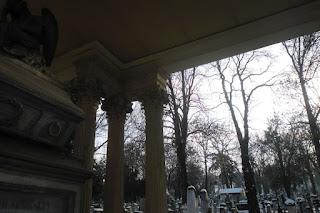Only 10 minutes walk from the Unirii Square in the centre of Cluj-Napoca The Hajongard Cemetery or Central Cemetery calls for a green walk in every season. You will submerge in a 17 hectare of thick dark romantic atmosphere of past and present, silence, beautiful trees and a pantheon of graves of notable local personalities from the past of Cluj and Transylvania. The oldest gravestone dates back to 1599.
More about the Central Cemetery of Cluj
It is one of the most picturesque sights of the city and covers an area of approximately 14 hectares. The cemetery holds the vaults of some old Hungarian princely and aristocratic families (Teleki, Bethlen, Kendeffy, Bánffy, Apor, etc.), as well as the grave of John Paget and that of Sámuel Brassai, reminiscent of the old days of Transylvania, which confer it a status of genuine open-air museum, and a spot of dense romantic atmosphere.
The name of the cemetery seems to have derived either from the name of the Saxon family Hazinschart, who owned the land that was turned into a cemetery during an epidemic outburst, or from the name of the garden where it was built – Hasengarten (Garden of Hares), or Haselgarten (Hazelnut Garden).
Since 1585, the Saxons, the Hungarians – Catholics, Lutherans, Reformed, Unitarians – but also the Armenians, Romanians or the community of Hochstadt (or Upper Town) laid gravestones and memorial monuments in the space that was then outside of the city gates of Cluj.
The first attestation of the Hajongard Hill, located south of the medieval city of Cluj, dates from 1503.The decision to establish the cemetery was taken by the authorities after the plague of 1585. The cemetery was enlarged several times, first during the seventeenth century when the Lutheran cemetery was established and in 1840.
In 1885 the cemetery was arranged, with many old stones being removed from their place, plots were designated and trees were planted. At the end of the nineteenth century the cemetery was expanded to the south, opening a cemetery for soldiers. The oldest headstone dates from 1599 and is located in the Lutheran cemetery.
Some the local Romanian and Hungarian personalities who have found rest in Central Cemetery of Cluj are: Ion Agârbiceanu, writer, journalist, politician, academician and archpriest, Emil Racoviță, explorer and founder of biospeology, Virgil Fulicea, sculptor, Gheorghe Dima composer,conductor and teacher, György Bánffy, governor of Transylvania, Miklós Bánffy, writer, illustrator, scenographer and foreign minister of Hungary,Jenő Janovics, actor and director, Sámuel Brassai, linguist and teacher,Imre Mikó, governor of Transylvania, János Kriza folklorist, Károly Kósarchitect and transylvanist.
The Hajongard Cemetery is officially known as the Central Cemetery(Hungarian: Házsongárdi temető, German: Hasengarten) on Avram Iancu Street, is one of the oldest cemeteries in Cluj, founded in the sixteenth century once the cemetery around St. Michael’s church in the city’s center became overcrowded.
All the pictures were taken by me during my various trips to Cluj Napoca.







































No comments:
Post a Comment